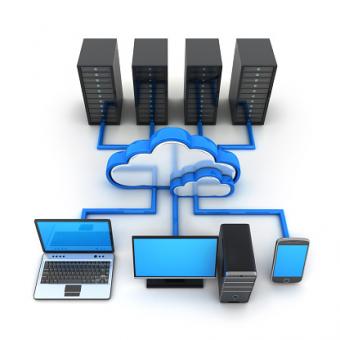
Many people use a variety of digital devices ranging from smartphones and tablets to laptops and desktop computers. While this can be handy for accessing the Internet, it can be difficult sharing or retrieving files across various machines. Dropbox is a system which specializes in sharing digital information across platforms to make the process easier.
Overview of Dropbox Accounts
Dropbox is a Cloud-based, file sharing system that allows users to upload or download documents, images, videos, text or code files, and audio clips. This system offers three types of accounts.
- Basic: This account is free and includes 2 GB of storage.
- Dropbox Pro: This service, which costs about $10 a month or approximately $100 annually (plus tax), comes with 1 TB of storage.
- Business: The cost for this package (based on a minimum of five users) starts around $75 a month, or about $750 yearly and includes unlimited storage space, unlimited file recovery, and phone support.
Opening an Account
Opening a Dropbox account is easy and requires just a few steps.
- Navigate to Dropbox.
- Click on "Create an account."
- Enter your email address and create a password. Use a strong password to ensure the content is protected.
- Verify the email address.
- Download the installation file.
- Install Dropbox on your machine.
Now your content can be accessed from any Web-connected device by logging into your Dropbox account. However, if you intend to access the content from your phone or tablet, you'll need to install the Dropbox app on those machines as well. One key advantage of this -- besides not having to access Dropbox through a browser -- is that some processes can be automated, such as backing up photos from your phone.
Before You Upload, Create a Folder
It's easy to understand how Dropbox works if you divide the system into its two main functions. The first is uploading or creating content. The other function is downloading or retrieving content.
Hierarchy Order
Since Dropbox is a folder-based system, organizing the folder hierarchy in a logical manner is the key to using it efficiently. This is especially true for large projects. Taking the time to create a logical, intuitive folder structure will save time in the long run, especially if other people will access the system. A well-crafted hierarchy helps users find files and folders easily without your assistance.
Creating Folders
Folders house all the files associated with a project. For example, if you are working on a genealogy project with relatives, create a folder and share it with everyone working on the project. Project members can upload images and documents, or they can retrieve what others have saved. In short, users will have access to what everyone else is working on. Also, since all the work on any shared file is automatically and seamlessly updated via the Web connection, everyone can view or use the latest file versions.
While inside the application, create a folder by:
- Right-clicking and then choosing "New Folder."
- Name the folder.
To Share the Folder:
- Hover over the folder with the mouse, right-click, and select "Share."
- This will generate a new window where you enter the person's email address. If you use the Pro or Business version, you can enter team members' names instead. These two versions also let you set permissions, such as read-only. In the free version, anyone you share a folder with can edit or delete files or folders.
When beginning a project, it's best to know who needs access to the folder before you create it. Many times, this is everyone on the team. However, you'll need to use a paid version of this software if you need to restrict a specific team member's permission level, such as someone who just needs read-only access.
Automatic Fixes for File and Folder Sharing Issues
There are some common problems users may encounter when working together on a project, but Dropbox has a way of addressing them.
- Two people using the same file at the same time: When sharing folders or the files inside the folders, it is possible for two or more people to access the same file at the same time which could result in work being overwritten. To prevent this, Dropbox creates two files and saves the work independently whenever two individuals are in the same file at the same time. Both files will reside in the folder the users were in when they created the files.
- Sub-folders: Storing multiple folders inside another folder is a common computer storage and filing method. This creates a potential sharing/permission problem, but Dropbox handles it by treating all sub-folders as children of the folder they are in. This means folders and sub-folders have identical permissions or rules. Just note it's not possible to create a different set of permissions on a sub-folder. If that is the goal, you should create a new folder.
Uploading Content
The ability to store a wide variety of files is another significant benefit of systems like Dropbox. Dropbox accepts all the common extensions used for photos, videos, and audio and text files. These files can be stored, uploaded, downloaded or shared across platforms.
All of this content can be added to your Dropbox account via the Website or through the app. When you use the mobile or desktop application, there is no size limit for a file as long as the account has available storage space. Files placed in your account through the site's upload icon must be 10 GB or less in size.
Via the Application
To place a file or folder from your computer into Dropbox, open the application and simply slide it into Dropbox. If the content needs to go inside a new folder, open the Dropbox application, create the folder, and then slide your file into the new folder. When you are on a mobile device, such as your phone, navigate to the file and click the share icon. Choose Dropbox from the list of options.
Via the Website
Another simple way to place content inside your account is to visit Dropbox.com and log into your account. Click on the Upload icon at the top of the dashboard and navigate to the file to begin the uploading process. You can also drag and drop the file onto the Web page instead of navigating to it.
Retrieving Content
Depending on how you access Dropbox, there are two basic methods you can use to retrieve, download or access your content. When accessing though a browser, just sign in and your content should appear on the dashboard. If it doesn't appear, click on the Dropbox icon which will take you to your home page where the content resides. Navigate to the folder holding the file you wish to access and then double-click on the file to open it.
If you do not have a Dropbox account, yet received an email which gave you access to another person's Dropbox file or folder, you'll need to:
- Click on the link.
- Download the file to your machine.
- After the file has downloaded, navigate to the content and double-click on the file or folder to open it.
- If you are altering the file, the updated file will need to be returned via email.
Solutions for Other Problems
Sometimes a user cannot find the content they created or the content someone else shared with them.
A Folder or File Was Lost
There are three general reasons for this dilemma. If you cannot access a file, ask yourself the following questions.
Was the file or folder deleted?
- Go online and sign into your account.
- Navigate to "Deleted files" (left sidebar).
- Click "Deleted files" and a list will populate.
- Hover over the file you need and click "Restore."
Note that in the free version, all deleted files or folders can be restored for 30 days, unless the file was permanently deleted.
Was the file or folder uploaded to Dropbox?
It is possible the content was never uploaded to Dropbox because an individual was working outside the application. If the person was working on a Word document and did not open it from inside Dropbox, the file was only saved locally on their machine and won't exist inside of Dropbox until they slide the file into the system. To avoid this situation always access the file by logging into Dropbox either from the desktop application or via the Web.
Have you been locked out?
Getting locked out occurs when the permissions on the folder have been altered and a person has, in essence, been denied access. If this is an error, contact the folder owner and have them re-attach you to the folder.
Unable to Download Content
If you received a link inviting you to the content, but the link won't let you in, it usually means the link has expired. You will need to request a new invitation. It's also possible you have been locked out of the content due to a change in permission on the folder. Again, you will need to contact the folder's owner.
Answers to Common User Questions
New users are bound to have questions about the system. Here are two of the most common ones.
Can Folders Be Shared With a Non-Dropbox User?
The short answer is yes. The main exception is if you are on a Business Plan, and the company has implemented rules to restrict sharing. Some businesses do not want their information shared, so they set up rules which prevent public sharing of their content. With the free version, you can share your folders and files with anyone. However, it is important to remember that recipients can edit or even delete the shared content since the free version does not permit read-only permission settings. To share your content with a non-Dropbox user, hover over the file or folder while you're in the application and click share. This will generate a pop-up window where you can add the recipient's email address.
What's the Process for Deleting a File or Folder?
Deleting a file is simple.
- Inside the Dropbox app, navigate to the file or folder.
- Hover over the item, right-click and click delete.
- You can also drag the file from Dropbox to the Trash can icon on your computer.
Note that you cannot restore the file from inside the app, you must sign in to your Dropbox account to access deleted files.
Choose the Right Dropbox Account
Deciding which type of Dropbox account to choose ultimately boils down to storage space; how much do you need? Even though 2 GB is quite a bit of space for document storage, you can use up space quickly if you store videos, photos or audio files. However, that might be fine if you only need to store those items temporarily. Businesses or individuals working on large projects with large files may want to consider the Pro version with its 1 TB of space to ensure they have adequate storage. Companies which need to place five or more employees on the Dropbox system will want to purchase the business plan. Consider your needs carefully and select the version that will truly suit your needs in the long run.







